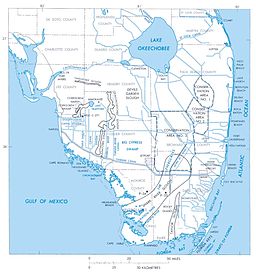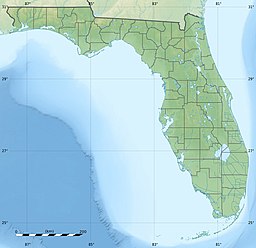
Back بحيرة أوكي تشوبي Arabic بحيرة اوكيتشوبى ARZ Окичоби Bulgarian Okeechobee Czech Окичоби CV Okeechobeesee German Lago Okiĉobi Esperanto Lago Okeechobee Spanish Okeechobee järv Estonian دریاچه اوکیچوبی Persian
| Lake Okeechobee | |
|---|---|
 Photographed from space, 2000 | |
 Shown at the top of this map of South Florida | |
| Location | Florida |
| Coordinates | 26°56′N 80°48′W / 26.933°N 80.800°W |
| Primary inflows | Kissimmee River, Fisheating Creek, Taylor Creek |
| Primary outflows | Everglades, Caloosahatchee River, St. Lucie River |
| Basin countries | United States |
| Max. length | 36 mi (57.5 km) |
| Max. width | 29 mi (46.6 km) |
| Surface area | 734 sq mi (1,900 km2) |
| Average depth | 8 ft 10 in (2.7 m) |
| Max. depth | 12 ft (3.7 m) |
| Water volume | 1 cu mi (5.2 km3) (estimated) |
| Residence time | 3 years |
| Surface elevation | 12 to 18 ft (3.74 to 5.49 m) |
| Islands | Kreamer, Torry, Ritta, Grass, Observation, Bird, Horse, Hog, Eagle Bay |
Lake Okeechobee (US: /oʊkiˈtʃoʊbi/ oh-kee-CHOH-bee)[1] is the largest freshwater lake in the U.S. state of Florida.[2] It is the eighth-largest natural freshwater lake among the 50 states of the United States and the second-largest natural freshwater lake contained entirely within the contiguous 48 states, after Lake Michigan.[3]
Okeechobee covers 730 square miles (1,900 km2) and is exceptionally shallow for a lake of its size, with an average depth of only 9 feet (2.7 metres). Not only is it the largest lake in Florida and the largest lake in the southeast United States, it is also too large to see across.[4] The Kissimmee River, located directly north of Lake Okeechobee, is the lake's primary source.[5] The lake is divided between Glades, Okeechobee, Martin, Palm Beach and Hendry counties. All five counties meet at one point near the center of the lake.[6]
- ^ "Okeechobee". Collins Dictionary. n.d. Retrieved 24 September 2014.
- ^ Gardner, Rusty. "Welcome to the Lake Okeechobee". Florida by Water.
- ^ Heather S. Henkel (2010-04-15). "SOFIA Virtual Tour – Lake Okeechobee". Sofia.usgs.gov. Archived from the original on 2011-05-18. Retrieved 2011-11-27.
- ^ Lecher, Alanna L. (January 2021). "A Brief History of Lake Okeechobee: A Narrative of Conflict". Journal of Florida Studies. 1 (9): 1–3.
- ^ "Lake Okeechobee | Location & Facts". Encyclopædia Britannica. Retrieved 2019-02-19.
- ^ Counties of Florida map from U.S. Census Bureau.

